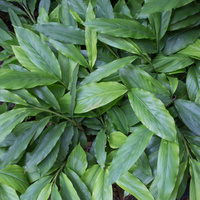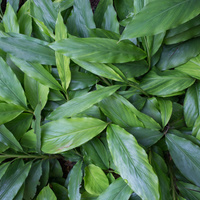Common name: Cardamom
Other common names: Cardamom, Cultivated cardamom, Mysore cardamom, Real cardamom
Description
Cardamom is a spice plant originating in the highland forests of Sri Lanka and the Western Ghats of India, a mountain range extending along the western fringe of the Indian peninsula.
Until the 1800's, the world's supply of cardamom came only from these forests and the cultivation practice at the time was to thin the trees to allow better access to the wild plants. Nowadays, cardamom is cultivated mostly in plantations, the largest of which are in India and Guatemala, in Central America.
There are two main Cardamom varieties, which have the unassuming names 'Variety major' and 'Variety minor'. Variety minor, which is the more widely cultivated of the two, is so named because it produces a smaller fruit and it comes in three cultivars or types, known as 'Malabar', 'Mysore' and 'Vazhukka'. Variety major is a wild form of cardamom and is nowadays rarely cultivated.
The plant is a herbaceous perennial with a clumping habit, having underground rhizomes that sprout leafy, herbaceous cane-like stems. Individual clumps are made up of about fifteen to twenty stems closely spaced and growing 2 to 4 m (6.5 to 13 ft) tall, depending on the variety and growing conditions. It is naturally an understory plant, preferring filtered or dappled sunlight coming through the tree canopy high above.
The leaves are sword-shaped, 30 to 90 cm (1 to 3 ft) long, dark lush green on top, pale green underneath and alternately arranged along the top half of the stem. They give off a spicy, ginger-like aroma when crushed.
The flowers are about 4 cm (1.6 in) long, orchid-like with pale green petals and a large, prominent white lip marked by violet or pink stripes. They come into bloom from spring through to autumn, in clusters at the ends of flower stalks up to 1 m (3.2 ft) long, arising from the base of the plant.
The flowers are followed by small, green, oval fruit, 1 to 1.5 cm (0.4 to 0.6 in) long with up to twenty small angular seed enclosed in three compartments. The seed are white in immature fruit, become dark brown when mature and are strongly and sweetly aromatic. In the Mysore variety, the fruit-bearing stalks are erect, with the fruit kept off the ground but in the Malabar variety are prostrate, with the fruit laying on the ground, resulting in a greater chance of them becoming spoiled.
Use
The whole dried fruit and seed are the Cardamom spice but it is the seed where the aroma and flavour are concentrated. The fruit are picked by hand, just before they are fully ripe and before they start to open. They are then washed, placed on mats in the sun to dry or are dried in low-temperature ovens or dehydrators so that the husk is not totally bleached of its green chlorophyll.
Dried Cardamom pods give off a strongly aromatic aroma when rubbed between the fingers and those of the Mysore type have a spicy flavour with citrus and floral notes, whereas the Malabar type is more reminiscent of camphor or eucalyptus.
In Arabic cuisine, cardamom is used for creating a cardamom flavoured coffee (Coffea arabica) known as 'Gahwa', a customary drink used to welcome guests. In Scandinavia, it is used as a flavouring in breads, sweet pastries and cakes. In India and Sri Lanka, it is mostly used in curry-mixes and spiced teas such as Chai. Elsewhere, it is used as a flavouring in frozen desserts, confectionery, pickles, relishes, chewing gum, tobacco and sausage meats.
The ground seed, on steam distillation, yield 3 to 5% of a pale green to yellow essential oil. It is used as a flavouring agent in baked goods and alcoholic beverages such as 'Amaro', a well known Italian liqueur consumed mostly as an after-dinner drink (digestif). Cardamom essential oil is also used as a fragrance component in cosmetic creams, soaps and quality perfumes such as 'Byzance' and 'Diva'.
Health use
Cardamom is well-known for its carminative and stomachic properties. It has long been used in traditional Indian or Ayurvedic medicine against digestive complaints, including indigestion, stomach pain, cramps and intestinal gas, and as an appetite and digestive stimulant. In China, it is used to treat urinary problems, particularly incontinence. It also used as a remedy for bad breath.
General interest
The use of cardamom, as a spice, is said to date back to the time of the Roman empire, in the first century AD. However, some historians claim its use in perfumes at the time of the Ancient Egyptians pre-dates its use as a spice. Cardamom is today the world's third most expensive spice by weight with only saffron and vanilla commanding higher prices.
Climate
Grows naturally in humid subtropical and tropical mid-to high-elevation climates, generally in frost-free areas with annual lows of 13 to 20°C, annual highs of 21 to 29°C, annual rainfall of 1200 to 6000 mm and a dry season of 4 months or less.
Growing
New plants are mostly started from divisions, which involves dividing established clumps into new plants which are then replanted, usually at the start of the rainy season. New plants can also be started from seed, which take about two to three months to germinate.
Performs best on rich, well-manured, free-draining clay and loam soils of a moderately acid to neutral nature, generally with a pH of 5.5 to 7.0, and on sites with light to medium shade.
Cardamom plants start to flower and fruit when about two to three years old and come into full bearing about two years after that. They are reported to have a productive life of up to twelve years. Average yields of green pods range from 168 to 280 kgs per hectare, or the equivalent of 150 to 250 lbs per acre. High-yielding cultivars reportedly yield up to 450 kgs per hectare (400 lbs per acre).
Problem features
It is recorded as naturalised in Laos, in Southeast Asia and as a weed in some locations, though not as a serious weed, and is assessed as a low weed risk species for Florida, by the IFAS Assessment of Non-Native Plants in Florida's Natural Areas.
Where it grows
References
Books
-
Adams, C. D. 1972, Flowering plants of Jamaica, University of the West Indies, Mona, Greater Kingston
-
Arctander, S. 1960, Perfume and flavor materials of natural origin, Elizabeth, New Jersey
-
Attokaran, M. 2011, Natural food flavors and colorants, Institute of Food Technologists, Wiley-Blackwell Publishing, Oxfordshire
-
Chevallier, A. 2000, Encyclopedia of herbal medicine, 2nd American ed., Dorling Kindersley, New York
-
Groom, N. 1997, The new perfume handbook, 2nd ed., Blackie Academic & Professional, London
-
Guenther, E. & Althausen, D. 1948 to 1952, The essential oils (6 volumes), Van Nostrand Publishing, New York
-
Khan, I. A. & Abourashed, E. A. 2010, Leung's encyclopedia of common natural ingredients : used in food, drugs and cosmetics, 3rd edition, Wiley Publishing, Hoboken, New Jersey
-
Lopez, C. & Shanley, P., 2004. Riches of the forest: food, spices, crafts and resins of Asia, Center for International Forestry Research (CIFOR), Bogor, Indonesia
-
Macmillan, H. F. 1943, Tropical planting and gardening : with special reference to Ceylon, 5th ed, Macmillan Publishing, London
-
McIlroy, R.J. 1963, An introduction to tropical cash crops, Ibadan University Press, Ibadan, Nigeria
-
Staples, G. & Kristiansen, M. S. 1999, Ethnic culinary herbs : a guide to identification and cultivation in Hawaii, University of Hawaii Press, Honolulu
-
Stewart, A. 2013, The drunken botanist : the plants that create the world's great drinks, 1st ed., Algonquin Books, Chapel Hill, North Carolina



.5735.thumb.jpg)

